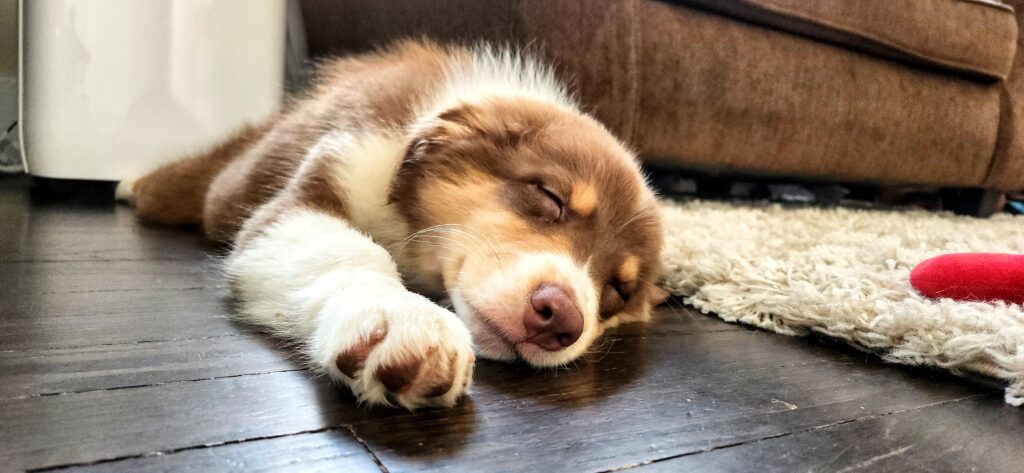
This post outlines lists my top thirteen tried and true new puppy essentials. There are few things more exciting than bringing a new puppy into your family. The first few months will have their challenges, but with these puppy essentials, you’ll be prepared for the adventure ahead!
If you’re currently planning on bringing a new puppy into your home or if you’ve recently added a puppy to your family, congratulations! I’m sure you’ll reflect on this time as one of the best decisions you ever made.
Raising a puppy can be difficult at times. They chew, bite, pee on the floor, have uncontrollable bursts of zoomies and can’t sleep through the night. It’s a good thing they’re so cute!
The hard times go by in the blink of an eye – almost as fast as it takes for them to be full-grown! To get you through the crazy puppy phase, check out these awesome products to make your puppy more comfortable and your life a little easier.
What to buy for a new puppy
These are the puppy essentials that your puppy needs, ideally before you’ve even brought them home:
- Collar & leash
- ID tag
- Front clip harness
- Crate
- Training treats
- Kong
- Nylabones
- Natural chews
- Nature’s Miracle Stain & Odor Remover
- High-quality puppy food
- Water & food bowls
- Puppy toys
- Dog bed
Not only will they be off to a better start, but these puppy products will make your life SO MUCH easier.
Collar & Leash
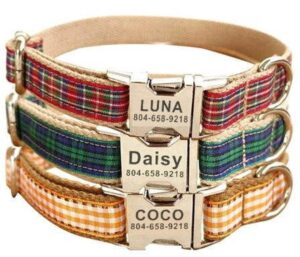
A high-quality collar and leash should be among the very first things you buy for your new puppy, ideally before you even bring them home. Collars provide you with some extra leverage for controlling your crazy pup and can hold your info in case they ever get lost. Combined with a leash, you can start training and walking them without worrying about them running away.
Correct collar sizing is important. You want to be able to comfortably fit a couple of fingers between the collar and their neck, but the collar should be tight enough that it won’t slip off when pulled.
You can expect to buy your puppy at least a couple of collars as they grow, so no need to obsess over their first collar. In a few months, you’ll likely be due to replace it!
Etsy has some adorable collars and leashes, many with a variety of customizations available. If that’s not your style, every pet store will have plenty of affordable options as well.
ID Tag
Whether your puppy is microchipped or not, it’s a good idea to buy them an ID tag sooner rather than later. In the event that they get lost and someone finds them, they’ll be able to get in touch with you.
At a minimum, include your dog’s name and your phone number.
Loads of fun metal tags can be purchased at your local Petco or chain pet store. Etsy has some unique options as well, like engraved leather or rubber.
Front Clip Harness
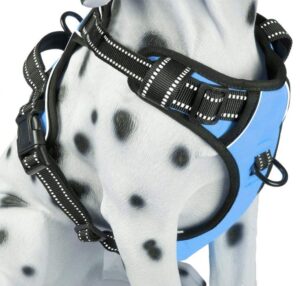
Once you’ve used a harness, you’ll never go back to using only a collar when you walk your dog! Harnesses are fantastic for training your dog on a leash and for better control. They are also more comfortable for your dog since the pressure from tugging will be distributed across their chest instead of around their neck.
Front clip harnesses are even better since they discourage pulling to begin with. If your dog does pull, they’re spun around to face you. That won’t get them where they’re trying to go! Seriously give one a try.
Both of my dogs immediately stopped pulling as much with a front clip harness.
Pick one with reflectivity for extra safety during walks at night.
Crate
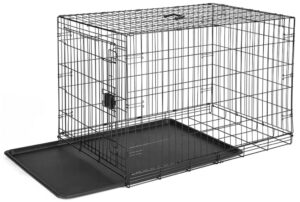
For reasons I can’t fully understand, crates have become quite controversial. Personally, I don’t know how anyone could survive the puppy phase without crate training. When I first brought Zion home, I couldn’t even run to get a glass of water without him getting into trouble!
Crates aren’t meant to be used as a punishment or substitute for effortful dog training. Instead, they are intended to be your puppy’s safe space to take breaks, chew or rest. Crates are also excellent tools for house training since puppies are less likely to go potty where they sleep. In a crate, they can still see what’s going on in the house while staying safe.
A classic wire crate will do the trick. Line the bottom with a comfy, inexpensive bed or mat (don’t spend much – it’ll almost surely take a beating). Pick a crate command and encourage your pup in with treats. Never leave a young puppy in a crate for more than a couple of hours at a time.
You can expect the first couple weeks of crate training to be exhausting, but in the long run, I’m confident you’ll be glad you stuck it out!
Training Treats
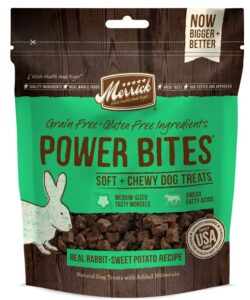
Training treats are puppy essentials, especially if your pup is food-motivated. When it comes to training a young puppy, nearly every waking moment is an opportunity for training. Are they behaving in a way you want to see more of? Treats! Are they misbehaving? Consider it an opportunity for teaching them what better behavior looks like.
The best training treats smell enticing and are very small. If you’re training all of the time, you may go through dozens, or even hundreds, of small treats each day.
If you find yourself going through loads of treats, you may want to consider finding a small bag of high-quality puppy food different from your pup’s normal diet. That way, the food will smell like a “treat”, but you’re actually rewarding them with a balanced diet snack. Win, win!
Kong
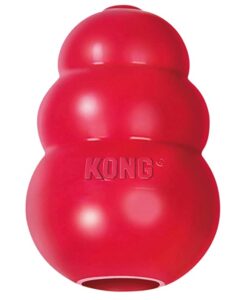
If I could choose the most lifesaving puppy essential when I first brought my dog, Zion, home, it would absolutely be his puppy Kong. Zion was a very high-energy little guy. He had two speeds: asleep and out-of-his-mind-insane.
In those moments when I would have sold a kidney just to sit down for five minutes, I gave him a stuffed Kong instead. Think of things like unsalted, unsweetened peanut butter, cheese, puppy treats, puppy food or pumpkin puree. Getting all the food out kept him entertained and engaged long enough for me to rest for a moment.
Pro Tip: Pre-stuff a Kong and throw it in the freezer. When you’re in a pinch and need to occupy your puppy for a few minutes, you’ll have a quick solution! Plus, freezing the goodies inside means it’ll take longer for your puppy to work it all out.
Nylabones
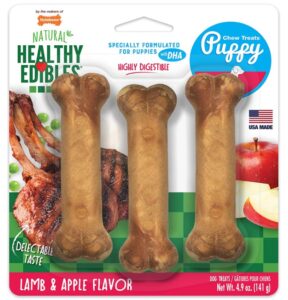
Puppies love to chew. If you don’t provide them with something acceptable to chew on, they’ll find something themselves. Perhaps they’ll choose your shoes, clothing, furniture or electronics – all of which will not leave you especially pleased. In my experience, the best way to get through the teething phase is to give your puppy lots of opportunities to gnaw on things that are okay to chew on.
Around the 3-4 months old mark, Zion’s favorite chews were the Nylabone Healthy Edibles. At first, they took him more than one chewing session to get through, but as he got older and stronger, these became little more than a quick treat.
Please don’t leave your puppy chewing these unattended. They are meant to break apart and be eaten, so the last bit of bone can be a choking hazard.
Natural Chews
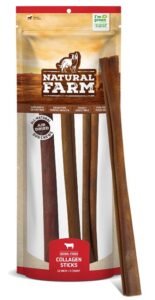
Once Zion grew out of the Nylabones, we had to step up to something more durable and long-lasting. These collagen sticks are great for heavier chewers. They’re not very wide – maybe an inch in diameter, at most – but they are pretty tough! My 7-month-old Aussie who loves to chew can get through one of the 12″ sticks in 3-4 20-minute chewing sessions.
Extra-large dogs probably need something even heavier to last a while, but I’d still recommend giving these a try!
The best thing about these chews is that they are nearly odorless. Some of the natural chews have a terrible smell and transfer color. These break down cleanly and don’t smell like much of anything.
Nature’s Miracle
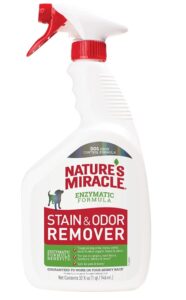
When housebreaking a new puppy, accidents are nearly inevitable. Puppies have a tendency to return to the same places they’ve gone potty before again and again. When that place is on your living room rug or in the middle of the hallway, you’ll want to nip that habit in the bud.
Pick up an enzymatic cleaning formula to thoroughly break down the odor. If your puppy can’t smell the old accident zone, they’re less likely to go there again.
Pro Tip: Let your puppy outside every half hour or so for the first few weeks. When they potty outside, get really excited. They’ll know they did a great job by waiting to go outside!
High-Quality Puppy Food
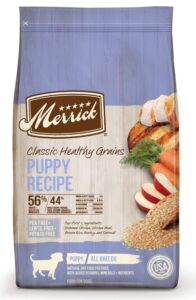
Choosing the right puppy food among a sea of options is so difficult. There is so much conflicting information out there. Is it okay for my puppy to eat grains? Should they only be eating raw? Are legumes safe? Is chicken better or beef? What does “natural” even mean?
I urge you to do some research before committing to a dog food brand. I’m not a dog nutritionist, so I won’t tell you what you should buy, but I can point you in an educated direction. Check out Dog Food Advisor to learn about what makes dog food “good” or “bad”. You can also review recalls and safety concerns.
Before you start your puppy on a grain-free diet, I’d also recommend doing some reading on diet-related cardiomyopathy. And, of course, before making any big changes to your dog’s diet, talk to your vet.
Food & Water Bowls
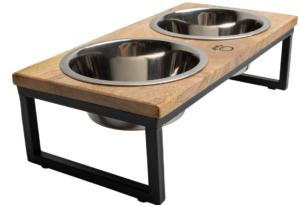
Dog bowls are a must! When choosing food and water bowls, it’s important to consider the size of the bowls in relation to the size of your new pup. The bigger the dog, the bigger the bowls need to be!
It is also a good idea to choose bowls that are made from durable materials that are easy to clean, such as stainless steel or ceramic. Avoid using plastic bowls as they can harbor bacteria and may not be as durable as other materials, like plastic. It is also a good idea to choose non-slip bowls to prevent spills and messes.
I love using this raised dog bowl setup with stainless steel bowls. It was super effective to get my puppy to stop dumping his water bowl out all over the kitchen floor.
Puppy Toys
Puppies love to play! If you walk through the toy aisle of a pet store, you’ll find endless options. Every puppy tends to have their own preference for the “best” toys. That said, I recommend choosing a variety of different dog toys at first so you can learn which are their favorites.
Some suggestions:
- A durable rope
- Something made of heavy rubber to chew on (Kong is a great brand)
- Plush toys
- A ball that is large enough that they can’t choke on it
- Toys that squeak or make noise
- Soft toys that are made to stick empty water bottles inside of
Once you figure out which toys they like best, get more of those! And keep in mind that your puppy’s preferences may change as they get older.
Dog Bed
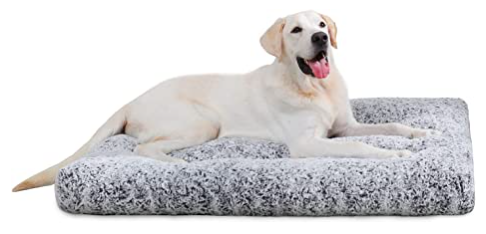
Offering your new puppy a cozy place to rest is good for their growing joints and comforting as they adjust to life away from their mother and littermates. At the same time, puppies can be unpredictable and sometimes destructive.
While your pup is still learning and exploring, don’t splurge on a luxury dog bed. The odds that the bed is peed on, chewed on and/or covered in dirty little pawprints within days is pretty high. Be sure your dog appreciates a warm bed before you spend much money on one. This one, at the time of writing, is only $25 for the large size!
Tips for the first 48 hours with a new puppy
Your new puppy essentials toolkit is loaded up and your new puppy is finally home! Now what?
Here are a few things you should do during the first couple of days with your new puppy:
Keep your expectations low and your patience high
Your puppy may just sleep. Or they may have little interest in you as they explore their new home. Maybe they will be so interested in you that you find your fingers, toes and clothing constantly chewed on.
Remember that they are still babies and have to be taught everything about you and the rules in their new home. Be super patient!
Puppy-proof your house
Pick everything up off the floor that you don’t want your puppy to chew on. Which is probably everything. Check out my experience with this in my post about the first month with my Australian Shepherd puppy, Zion.
If a valuable item is below your waist level, it’s probably not safe. Either move it to another room, put it up somewhere higher or create a barrier around it.
Block off access to anything that could be harmful to your new puppy, like houseplants, ant traps and household cleaners.
Close off any rooms you don’t want your new pup to have access to. Keep doors shut or put up baby gates.
Create a schedule and stick to it
Puppies (and dogs) thrive on structure. Feed your new puppy at the same time every day. Young puppies should eat three times a day, so choose a good time for breakfast, lunch and dinner.
Puppies sleep a lot. Building a nap schedule into each day can make a world of difference for both of you. Your puppy will be well rested and you can bake time into the day to do non-puppy things. A new puppy can become really consuming. This time is lifesaving!
Last, but certainly not least, stick to a strict potty schedule. Young puppies need to go outside A LOT if you want to housetrain them quickly. While they’re awake and playing, take them outside every 15-20 minutes. Go outside with them and give them loads of praise for pottying outside. If the neighbors aren’t worried about your mental stability, you’re not getting excited enough.
Schedule a vet appointment
Puppies need to see a vet about every month for the first few months of their lives. Within the first couple of days, don’t forget to schedule a vet appointment.
Before they’ve received important vaccinations, like Parvo, avoid taking your puppy anywhere dogs frequently visit and don’t introduce them to any unvaccinated dogs.
Read More: The Hidden Reality of the Crazy Puppy Phase | A Moral Support Post
With these must-have new puppy essentials and tips, along with loads of your patience and understanding, you’ll set your newest family member up with the ingredients for a great puppyhood.
Are there any other puppy products that you couldn’t have lived without during the puppy phase? Please share in the comments!
Good luck and happy puppy parenting!
Sincerely,
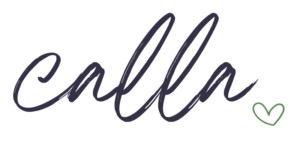
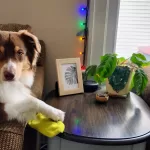
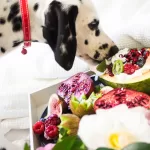

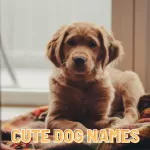

Leave a Reply